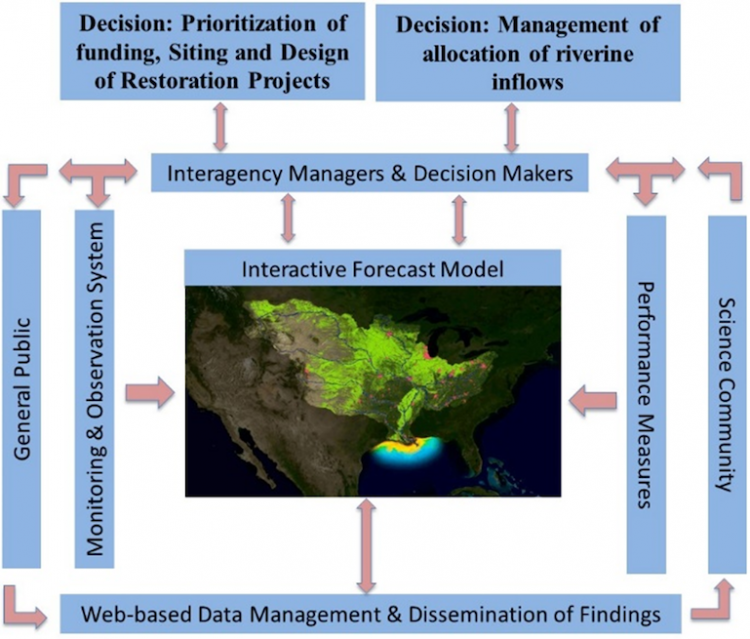Full Title: From planning to adaptive management: Natural resources decision making in response to the allocation of riverine inflows in the northern Gulf of Mexico
This project resulted in a management and forecast system that allows resource managers to explore tradeoffs from restoration strategies as well as examine and optimize various riverine inflows.

Lead Investigator: Ehab A. Meselhe, Tulane University, emeselhe@tulane.edu
Natural Resource Managers: Steve Giordano (National Marine Fisheries Service) and James Lewis (U.S. Army Corps of Engineers)
Collaborators: Mead Allison, Barbara Kleiss (Tulane University); John White (Louisiana State University); Kemal Cambazoglu, Jerry Wiggert (Univ of Southern Mississippi); Hanqin Tian (Auburn University); Kristy Lewis (Univ of Central Florida); Shannon Martin (University of Miami); Gregory Steyer (USGS); Marc Nelitz (ESSA Technologies); Holly Madill (National Charrette Institute – Michigan State Univ); Andrew Fischer (LA Department of Wildlife and Fisheries); Amy Hunter (AL Department of Conservation and Natural Resources); Julie Whitbeck and Mark Ford (NPS); Trey Flowers (NOAA – National Water Center); Burke (NOAA – NOS)
Federal Program Officer/Point of Contact: Frank Parker (frank.parker@noaa.gov)
Award Amount: $124,926
Award Period: September 2021 – August 2023
Why it matters: An estimated 79 to 92% of all freshwater enters the Gulf from the Mississippi River system. This riverine inflow brings freshwater, sediments, and nutrients into the system, potentially causing negative impacts such as hypoxia, high turbidity, and harmful algal blooms. In addition, the Gulf is impacted by human-induced freshwater inflows such as the opening of the Bonnet Carré Spillway. However, uncertainties regarding the effects of inflows make it difficult for federal agencies to properly prioritize funding for restoration projects designed to mitigate these negative impacts.
What the team did: The project team conducted a review of existing information related to the complexities of riverine systems, current forecasting models, and the procedures for operating engineered structures that control inflows. They also held a charette in order to share knowledge among researchers and natural resource managers and to identify knowledge gaps and research priorities.
Summary of outcome: The team’s effort led to the design of a coastal model that natural resource managers can use to support decisions regarding freshwater inflows. The team outlined a web-based portal where managers can use the model to forecast basin conditions in the timeframe of days to weeks or browse scenarios to gain an understanding of the system response to management. Resource managers can also tailor the model inputs to their specific management question. The team developed a series of potential use cases for this model such as understanding the physical and ecological effects of freshwater allocation. The team plans for this tool to be iterative in order to keep it up to date with current conditions.
Not applicable
Oct. 13, 2021 – NCI to partner on NOAA RESTORE grant to Develop the Framework for a Decision-Making Tool for the Gulf of Mexico, Michigan State University National Charrette Institute
Sept. 29, 2021 – Tulane scientist to lead research project on sustainability of Gulf of Mexico ecosystem, Tulane University
Take a look at the team website.
 Official websites use.gov
A .gov website belongs to an official government organization in the United States.
Official websites use.gov
A .gov website belongs to an official government organization in the United States.
 Secure .gov websites use HTTPS
A lock or https:// means you’ve safely connected to the .gov website. Share sensitive information only on official, secure websites.
Secure .gov websites use HTTPS
A lock or https:// means you’ve safely connected to the .gov website. Share sensitive information only on official, secure websites.